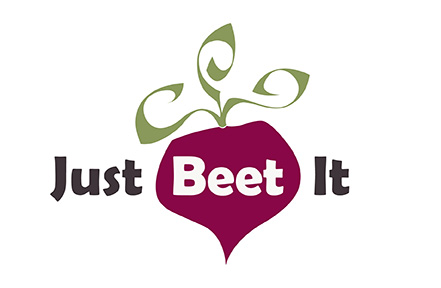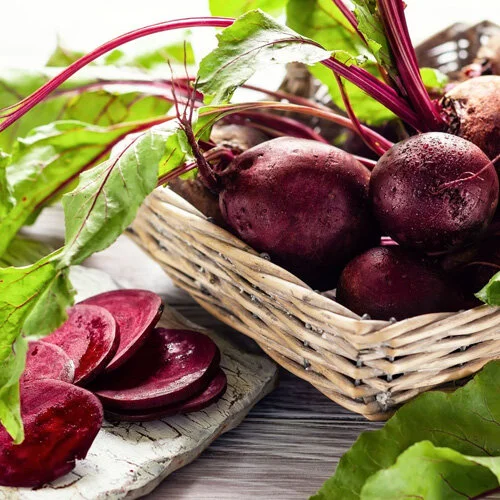Although we are most familiar with the red table beet, the quirky root vegetable that stains its way to the dinner table, the beet offers more than its famed vibrant red hues. Beet varieties and types range in sizes and colors, such as golden yellow, scarlet red, and "candy-cane" pink and white stripes.
If you are interested in adding beetroots and beet greens to your recipe or garden repertoire, there are various types of beets to consider depending on your preferences. For beet non-enthusiasts interested in enjoying the benefits of beets without the intense "earthy" flavor, choose a Red (Detroit Dark Red or Red Ace) or Golden Beet variety and perhaps avoid the Chioggia Beet. This beetroot is strikingly beautiful (looking like a candy-cane) and quite sweet in taste; however, the Chioggia Beet has the highest level of geosmin which contributes to the "dirt-like" taste. For beet lovers, the Chioggia Beet variety may spark the perfect root vegetable love affair with its delicious blend of earthy sweetness.
Beets, with their unique flavors and vibrant colors, create an endless array of tasting and gardening opportunities for recipes and nutrients.
BEETROOT VARIETIES AND TYPES
RED BEETS
Boltardy: It is hardy and bolt resistant. Many gardeners prefer growing this variety.
Detroit Dark Red: This red table beet contains a relatively low concentration of geosmin (lower levels create a less "earthy" taste) which makes this a popular commercial beet commonly sold in markets.
Lutz Green Leaf: This beet variety grows much larger than most beets, but it tastes sweeter if it is harvested on the small side.
Red Ace: This is the principal beet, grown in the United States; it has a bright red root and red-veined green foliage. This table beet is grown commercially and sold in markets.
Warrior: A relatively new hybrid, this beet was bred to be a deep red (on the outside and inside) as well as to be tender and sweet.
GOLDEN OR YELLOW BEETS
Burpee's Golden: Bred for the distinct yellow color, the roots contain orange or rosy skin with golden yellow flesh. Golden beets are sweet in taste and less likely to stain your hands, cutting board, counter tops, etc.
CHIOGGIA BEETS
Chioggia Barbabietola (candy-cane stripe): This is an Italian heirloom variety that contains distinct concentric rings of red and white flesh. Chioggia Beets are quite sweet, and when sliced, the contrasting red and white colors appear. When cooked, the flesh turns pale pink.
This variety contains higher levels of geosmin. Therefore, if you are not a fan of the "earthy" flavor associated with beets, this variety may not resonate with your taste buds.
Recipes: Raw Chioggia Beet Salad with Honey-Lime Vinaigrette and Beet Spring Rolls with Almond Butter, Lime and Ginger Sauce (Vegan)
SUGAR BEETS
The Sugar Beet is a different variety of beet that is grown (usually commercially) and processed as table sugar, animal food, and other products. Sugar Beets, white in color and sweet in taste, are larger than ordinary garden beets with roots that often measure 6-inches or more across.
BABY BEETS
What is a "baby beet"? Baby Beets, often cooked, packaged, and sold in grocery stores are beets that are harvested to thin the field and make room for other beets to grow. You can find packaged read-to-eat Baby Beets, such as LoveBeets at your local grocery store. Baby Beets are tender and have beautiful, luscious leaves. Don't forget to give some love to beet greens as they are highly nutritious!
OTHER BEETS
Albina Aereduna or Blankoma: These are a sweet white-colored variety.
Green Top Bunching: This variety is grown mostly for its full, lush green tops. The roots are tasty but not as popular as the greens.
BEET GREENS AND STEMS
Although many people are familiar with eating the root portion of the beet, historically, beet greens were consumed more than beetroots. Beet greens are filled with nutrients, such as Vitamin A, K, and C plus abundant minerals.
Not sure how to prepare beet leaves (greens)? Beet greens are incredibly diverse and can be added to smoothies, chopped raw for salads, or sauteed with garlic and lemon juice.
Did you know that the beet is edible from root to leaf? Rather than throwing away the nutritious and delicious beet STEMS, create a tasty Quick-Pickled Beet Stems side-dish.
For more tips on selecting, storing, and using beets in recipes, see the following: Tips for Selecting and Storing Beets and How To Eat Beets?
Reference
Morgan, Diane. (2012). Roots: The Definitive Compendium with more than 225 Recipes. San Francisco, CA: Chronicle Books LLC.
YOU MAY ALSO LIKE












